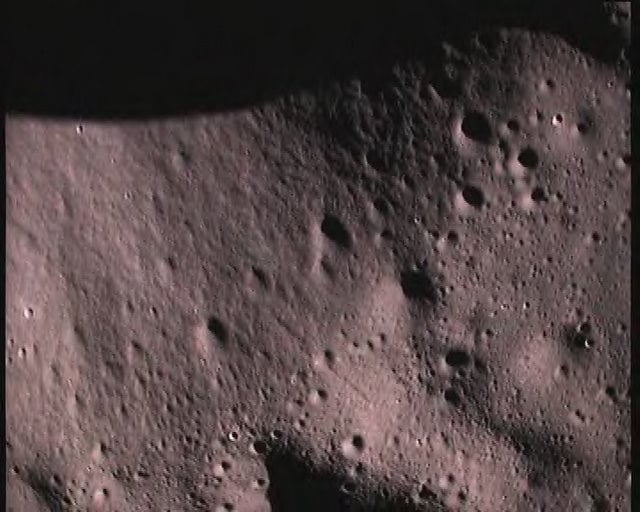[/caption] The lunar impactor from the Chandrayaan-1 mission today successfully made it to the surface of the moon, impacting inside the Shackleton crater on the moon's south pole. Above is an image transmitted back by the 34 kg box-shaped MIP (Moon Impact Probe) before it slammed into the moon.
Incoming!!!
The MIP carried three instruments, and data was successfully transmitted from the 25-minute descent of the probe after it was ejected from the orbiting Chandrayaan-1. The impact, however caused a cessation of the instruments' transmissions, but not before providing useful descent data. The ISRO has already released a couple of images.
[caption id="attachment_21111" align="alignnone" width="580" caption="close up pictures of the moon's surface taken by Moon Impact Probe (MIP) on November 14, 2008 "]
[/caption] The instruments included a video imaging system, a radar altimeter and a mass spectrometer. The video imaging system took pictures of the moon's surface as MIP approached and the radar altimeter measured the rate of descent. These two instruments will help subsequent lunar missions for the ISRO, aiding in future soft landing missions to the moon. The mass spectrometer studied the extremely thin lunar atmosphere.
[caption id="attachment_21098" align="alignnone" width="250" caption="The MIP. Credit: ISRO"]
[/caption] Here's a recap of the probe's mission today from the ISRO:
"MIP's 25 minute journey to the lunar surface began with its separation from Chandrayaan-1 spacecraft at 20:06 hrs (8:06 pm) IST. This was followed by a series of automatic operations that began with the firing of its spin up rockets after achieving a safe distance of separation from Chandrayaan-1. Later, the probe slowed down with the firing of its retro rocket and started its rapid descent towards the moon's surface. Information from the instruments was radioed to Chandrayaan-1 by MIP. The spacecraft recorded this in its onboard memory for later readout. Finally, the probe had a hard landing on the lunar surface that terminated its functioning."
Chandrayaan-1 is now in its science orbit. During the spiraling flight to the moon, two payloads were turned on – the Terrain Mapping Camera (TMC) and Radiation Dose Monitor (RADOM). The eight other instruments on board will be activated in the coming days.
Source: ISRO
 Universe Today
Universe Today
